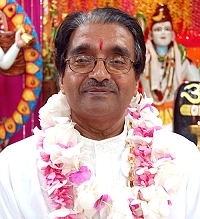Paramacharya of SWAHA, Pt. Hardeo Persad
What is truth? We say Truth is God, God is Truth. Truth is ‘That which is’. In life, everything we say or do is coloured based on our emotions and circumstances. ‘Rang’ means ‘colouring’; each colour has certain connotations and represents Divine qualities. To colour oneself implies, not a physical colouring but acquiring a certain quality. The colour of the lens in our glasses determines the way that we perceive the world. When we say Truth is That which is, it means that truth is not coloured by emotion or any other factor. There is no subjectivity involved. Words, for example, have different connotations, which create ambiguity. They are not THE Truth; they are your truth or my truth.
We all suffer from five mental afflictions:
- Agyaan or ignorance, which colours everything;
- Asmitha or ego;
- Raag or attachment;
- Dvesha or aversion;
- Abhinivesh or fear of death.
Ignorance clouds everything: our attitudes, our speech, our thoughts and our behaviour. It is therefore difficult to maintain the truth. Perception may not be the truth, but people’s perception becomes reality. Truth is unchangeable, infallible; it is a power in itself, shakti. The ancient philosopher Chanakya Maharaj has said that Truth needs no support; it can stand on its own. It cannot be suppressed for all time. It is self-effulgent; it shines on its own. Truth is Divinity. Chanakya has said that the truth stabilises the world. It makes the sun shine and the wind blow. Truth alone establishes the order in creation. Scriptures state that this creation has four ages: Sat, Treta, Dwapar and Kal Yug. Each of these four ages represents the principles of Sanatan Dharma. In Satyug, the Age of Truth, the four principles of dharma, austerity, purity, charity and truthfulness, are maintained. The analogy is of a bull that stands on four legs. In Treta Yug, when doubt, attachment and pride entered into the world, one of the feet of the bull disappears, and another in Dwapar Yug. In Kalyug, dharma stands on only one foot – truthfulness.
There is an ancient tale of four blind men who encounter an elephant. Each tries to conceptualise the elephant by describing a part of it – the tusk, the trunk, the belly, the leg. They then argue that their view is right and the other views are wrong, even though none has perceived the elephant in its entirety. Their perceptions are based on a limited, subjective experience of the elephant. It is a cautionary tale that our perceptions are limited and not the absolute Truth. There is a difference between the Truth, belief systems and religious practices. The Truth is That which is; our belief systems and religious practices are aimed at helping us to discover the Truth. Our religious rituals, pujas, havans and so forth, are instruments to guide us to a higher level. They purify the five tattvas (elements) as well as the five gyaan indriyas (senses) that are linked to these elements. Over many lifetimes, we are each on our own journey to uncover the Divine Truth that is hidden within us.
Extracted from an interview on 90.5FM



